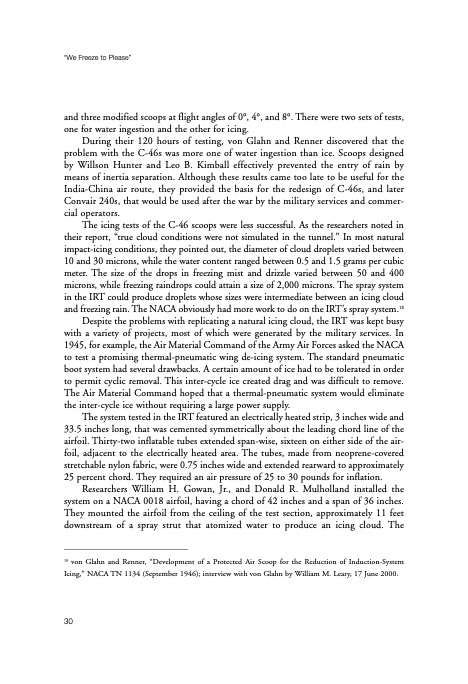
PDF Publication Title:
Text from PDF Page: 043
“We Freeze to Please” and three modified scoops at flight angles of 0°, 4°, and 8°. There were two sets of tests, one for water ingestion and the other for icing. During their 120 hours of testing, von Glahn and Renner discovered that the problem with the C-46s was more one of water ingestion than ice. Scoops designed by Willson Hunter and Leo B. Kimball effectively prevented the entry of rain by means of inertia separation. Although these results came too late to be useful for the India-China air route, they provided the basis for the redesign of C-46s, and later Convair 240s, that would be used after the war by the military services and commer- cial operators. The icing tests of the C-46 scoops were less successful. As the researchers noted in their report, “true cloud conditions were not simulated in the tunnel.” In most natural impact-icing conditions, they pointed out, the diameter of cloud droplets varied between 10 and 30 microns, while the water content ranged between 0.5 and 1.5 grams per cubic meter. The size of the drops in freezing mist and drizzle varied between 50 and 400 microns, while freezing raindrops could attain a size of 2,000 microns. The spray system in the IRT could produce droplets whose sizes were intermediate between an icing cloud and freezing rain. The NACA obviously had more work to do on the IRT’s spray system.18 Despite the problems with replicating a natural icing cloud, the IRT was kept busy with a variety of projects, most of which were generated by the military services. In 1945, for example, the Air Material Command of the Army Air Forces asked the NACA to test a promising thermal-pneumatic wing de-icing system. The standard pneumatic boot system had several drawbacks. A certain amount of ice had to be tolerated in order to permit cyclic removal. This inter-cycle ice created drag and was difficult to remove. The Air Material Command hoped that a thermal-pneumatic system would eliminate the inter-cycle ice without requiring a large power supply. The system tested in the IRT featured an electrically heated strip, 3 inches wide and 33.5 inches long, that was cemented symmetrically about the leading chord line of the airfoil. Thirty-two inflatable tubes extended span-wise, sixteen on either side of the air- foil, adjacent to the electrically heated area. The tubes, made from neoprene-covered stretchable nylon fabric, were 0.75 inches wide and extended rearward to approximately 25 percent chord. They required an air pressure of 25 to 30 pounds for inflation. Researchers William H. Gowan, Jr., and Donald R. Mulholland installed the system on a NACA 0018 airfoil, having a chord of 42 inches and a span of 36 inches. They mounted the airfoil from the ceiling of the test section, approximately 11 feet downstream of a spray strut that atomized water to produce an icing cloud. The 18 von Glahn and Renner, “Development of a Protected Air Scoop for the Reduction of Induction-System Icing,” NACA TN 1134 (September 1946); interview with von Glahn by William M. Leary, 17 June 2000. 30PDF Image | History of NASA Icing Research Tunnel

PDF Search Title:
History of NASA Icing Research TunnelOriginal File Name Searched:
sp4226.pdfDIY PDF Search: Google It | Yahoo | Bing
NFT (Non Fungible Token): Buy our tech, design, development or system NFT and become part of our tech NFT network... More Info
IT XR Project Redstone NFT Available for Sale: NFT for high tech turbine design with one part 3D printed counter-rotating energy turbine. Be part of the future with this NFT. Can be bought and sold but only one design NFT exists. Royalties go to the developer (Infinity) to keep enhancing design and applications... More Info
Infinity Turbine IT XR Project Redstone Design: NFT for sale... NFT for high tech turbine design with one part 3D printed counter-rotating energy turbine. Includes all rights to this turbine design, including license for Fluid Handling Block I and II for the turbine assembly and housing. The NFT includes the blueprints (cad/cam), revenue streams, and all future development of the IT XR Project Redstone... More Info
Infinity Turbine ROT Radial Outflow Turbine 24 Design and Worldwide Rights: NFT for sale... NFT for the ROT 24 energy turbine. Be part of the future with this NFT. This design can be bought and sold but only one design NFT exists. You may manufacture the unit, or get the revenues from its sale from Infinity Turbine. Royalties go to the developer (Infinity) to keep enhancing design and applications... More Info
Infinity Supercritical CO2 10 Liter Extractor Design and Worldwide Rights: The Infinity Supercritical 10L CO2 extractor is for botanical oil extraction, which is rich in terpenes and can produce shelf ready full spectrum oil. With over 5 years of development, this industry leader mature extractor machine has been sold since 2015 and is part of many profitable businesses. The process can also be used for electrowinning, e-waste recycling, and lithium battery recycling, gold mining electronic wastes, precious metals. CO2 can also be used in a reverse fuel cell with nafion to make a gas-to-liquids fuel, such as methanol, ethanol and butanol or ethylene. Supercritical CO2 has also been used for treating nafion to make it more effective catalyst. This NFT is for the purchase of worldwide rights which includes the design. More Info
NFT (Non Fungible Token): Buy our tech, design, development or system NFT and become part of our tech NFT network... More Info
Infinity Turbine Products: Special for this month, any plans are $10,000 for complete Cad/Cam blueprints. License is for one build. Try before you buy a production license. May pay by Bitcoin or other Crypto. Products Page... More Info
| CONTACT TEL: 608-238-6001 Email: greg@infinityturbine.com | RSS | AMP |